Spring came in with a vengeance on Good Friday, March 21, 1913, as a storm with winds clocked at 60 mph tore up Fort Wayne. It ripped roofs off buildings, toppled chimneys, yanked up trees and smashed a stained glass window at the Cathedral of the Immaculate Conception, keeping people away from Good Friday services.
On Easter Sunday, a steady rain prevented women from turning out in their Easter bonnets, and the Easter parade was canceled.
The Friday storm and the Sunday rains, however, proved to be merely a foreshadowing of what was to come in the next few days.
By the end of the week, the Flood of 1913 would go down in history as Fort Wayne's most devastating flood. When it was over, 5,500 houses and businesses had been damaged by water. The flood left about 15,000 people homeless and caused about $4.8 million in damage.
The flooding, which swept over a wide swath of the Midwest, also left tens of thousands homeless elsewhere in Indiana.
The following day-by-day account of the flood in Fort Wayne was compiled by reviewing coverage that appeared in two local daily newspapers, The Fort Wayne Sentinel and The Fort Wayne News, and also from News-Sentinel archives.
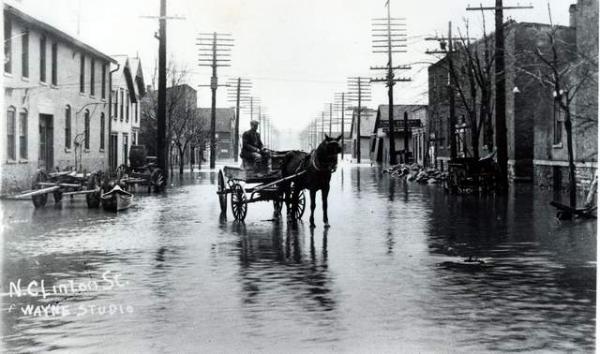 |
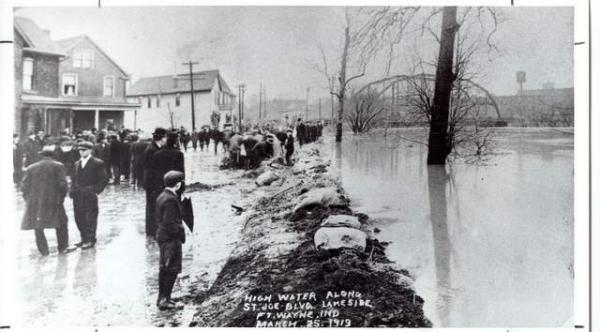 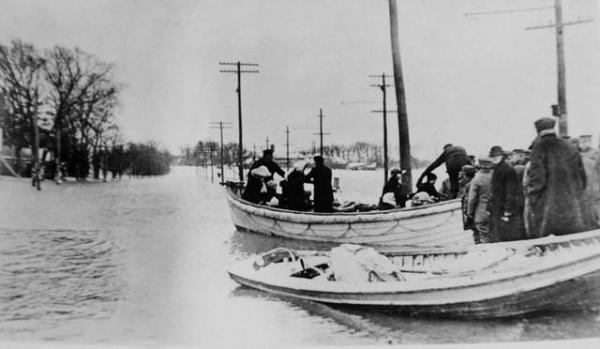 |
From left: An unidentified man drove his carriage on a flooded North Clinton Street. (News-Sentinel file photo), This view looks south down St. Joe Boulevard toward the Columbia Street Bridge. Efforts to reinforce the riverbank with sandbags didn't prevent the road from flooding. (News-Sentinel file photo). U.S. Coast Guard boats rescued Allen County Orphan's Home residents the day after four orphans drowned. (Photo courtesy of The History Center)
Monday, March 24, 1913
In the wee hours of the morning, 20 nurses, asleep in the St. Joseph Hospital convent, awoke when another storm blew through, ripping off the roof and throwing the hospital's smokestack through the roof of the chapel.
No one was injured, but the Fort Wayne News reported “the patients in the hospital became wildly excited at the noise … and could not all be quieted before daybreak.”
While damage from the wind, which reached speeds of up to 52 mph, was over in a matter of minutes, another menace from the storm would prove to be much more insidious. Torrential rainfall over 24 hours reached 2.76 inches, causing the rivers to rise 12 feet in one day.
By Monday evening, water surrounded 42 houses on Wagner Street, Baltes Avenue and Prospect Avenue.
“The extremely sudden rise of the river caught the Baltes Avenue residents unprepared,” the News said. “When they retired last night, their homes were high and dry — but during the night they were awakened by the gurgling of water over the carpets in their parlors, and the morning sun revealed a state of high water that was the equal of anything which has visited the city for the past seven years.”
Many residents evacuated, but some remained in their homes.
The Spy Run approach to the Tennessee Avenue Bridge also was underwater.
Shortly before noon Monday, a group of men started to fill in the cuts at both sides of the north end of the Coombs Street Bridge with sandbags. County commissioners and a bridge superintendent spent part of the day at the site.
“It looks very bad,” said County Commissioner William Schwler, “but we do hope to have it in hand by night.”
Tuesday, March 25, 1913
Commissioner Schwler had one thing right: It was very bad.
The first water began flowing into Lakeside at 8 a.m., at the foot of the Tennessee Avenue Bridge.
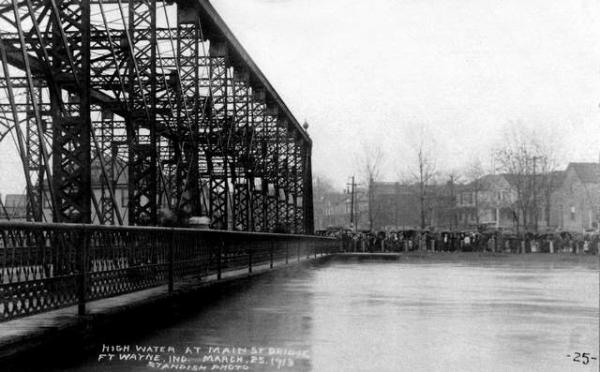 |
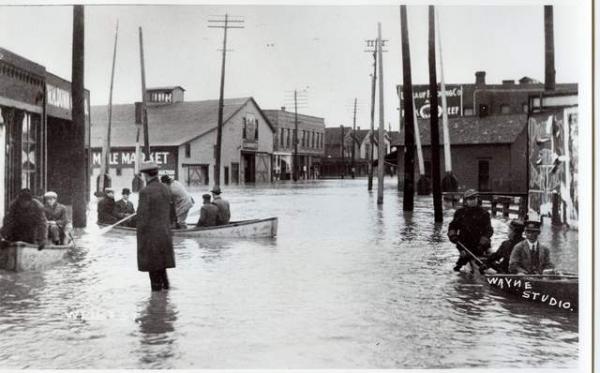 |
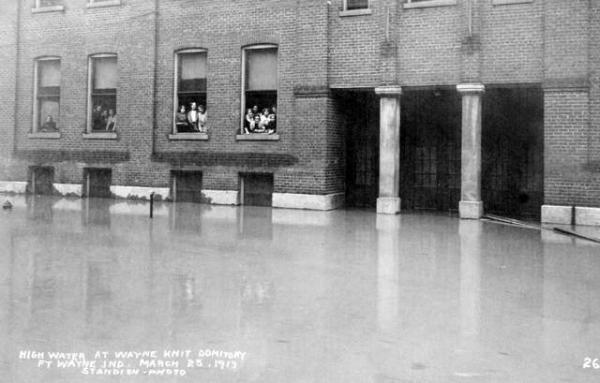 |
Over on Wagner Street, flooded from end to end, rescuers in boats worked to save those stranded in their houses.
But the city faced another serious problem. Floodwaters seeped into water-pumping stations, putting them out of commission. Amid overflowing rivers and flooded streets, the city faced a water shortage. A south-side reservoir didn't contain enough water to sustain the city even for a day.
At 2 p.m., Fort Wayne Mayor Jesse Grice decided to shut off city water, ordering the big valve at the city reservoir closed, to be opened only in case of fire.
A miserable situation grew worse as residents were forced to boil rainwater.
Floodwaters also knocked out the city's lighting and power plant, leaving the city dark.
Factories and schools closed.
Stores reportedly sold every pair of hip boots in the city by noon.
By the end of the day, 3,000 families were homeless, and
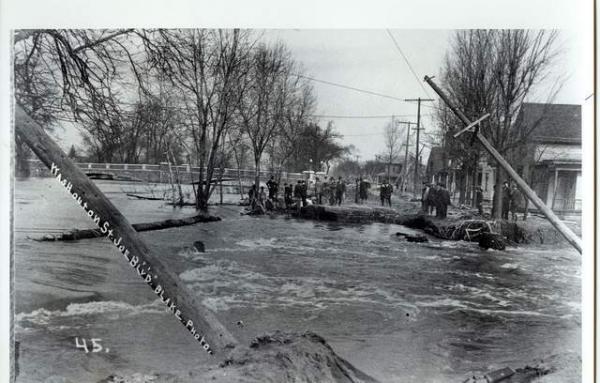 |
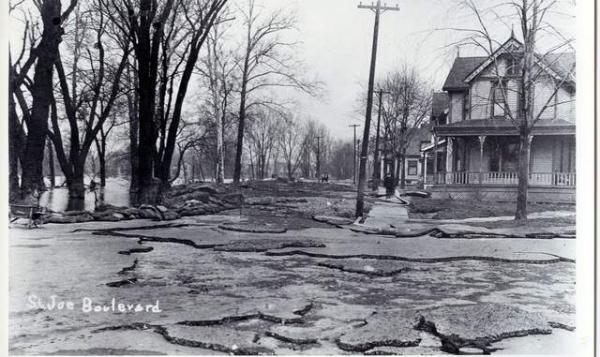 |
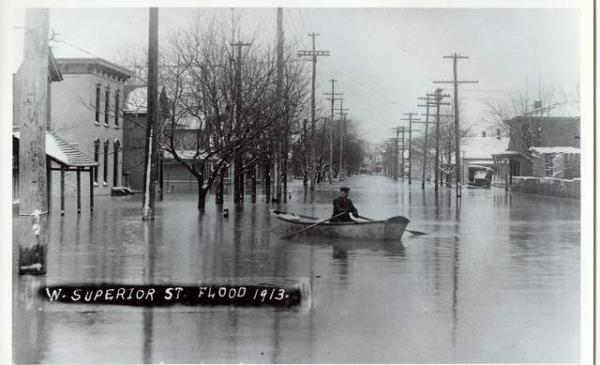 |
But the worst was still to come.
Wednesday, March 26, 1913
By Wednesday morning, the situation was dire at the Allen County Orphan's Home, situated in a bend of the St. Marys River west of Foster Park. On Tuesday, about 60 children and their caretakers were moved to the second floor of the building. Stoves were moved upstairs as well. But as the fuel supply started to run out, a township trustee decided to evacuate them.
On Wednesday morning, as rescuers prepared to evacuate the home, about 2 feet of water covered the first floor. Charles Gephart manned the oars of one boat that rowed out to rescue a group of children. Theresa Hammond, a caretaker at the home, ushered six girls into the boat: Esther Kramer, 14; Alice Mannen, 14; Ardah Woods, 15; Kittie Wise, 7; Opal Jacobs, 6; and Della Sturm, 6.
The children were told to be brave and sit quietly as Gephart drew on the oars. Those watching from the home were terror-stricken as they watched Gephart lose control of the boat in the rushing waters of the river.
The boat rammed into a telephone pole and capsized. Hammond and Gephart grabbed the pole, and with their free hands, they grabbed Opal and Della's clothing. As for Kittie, one account says she slipped underwater and grabbed Hammond's waist, but opened her mouth, swallowing water. Gephart saw Kittie underwater and grabbed her clothing with his teeth, but according to the account, by that time she looked dead to Gephart, so he let her go in order to save the living.
She disappeared, along with the other three, Esther, Alice and Ardah, “whose frantic cries were soon hushed as the muddy, turbulent waters covered them from sight,” the Fort Wayne Sentinel reported.
The flood claimed another life that day as Peter G. Monnock, who had assisted in rescue efforts all day Tuesday, died suddenly Wednesday morning while seated at the breakfast table at George Monnett's home. Officials cited heart failure resulting from exposure as the cause of death.
Meanwhile, most of the people in the Nebraska, Lakeside, Bloomingdale, Spy Run and other flooded neighborhoods had been evacuated. Efforts continued to restore power and water. The Maumee River crested at 11 p.m. at 26.1 feet, more than 11 feet above flood stage.
Thursday, March 27, 1913
After the disastrous attempt at rescuing the children and adults at the orphan's home on Wednesday, a crew of experts from Chicago rushed to Fort Wayne on a special train to rescue those still stranded there. On Thursday morning, the 55 remaining people were rescued.
As The Fort Wayne Sentinel described it, “As the big motor boat with a supply of provisions and the last load of human freight pulled away from the building, the last porch that clung to the structure was swept away by the surging waters that for many hours had held helpless women and children in its grasp.”
Only one child was afraid: little Opal Jacobs, the 7-year-old who was thrown from the boat the day before and nearly swept away. She had to be forced into the motor boat.
The captain shouted directions in nautical terms during the five trips it took to evacuate the home. In a biting wind that whipped the water into waves, the boat crew delivered the children and their caretakers to safety onshore, where others whisked them away in cars to a church.
Meanwhile, a rumor that the big dam at St. Mary's, Ohio, had given way sent residents of Fort Wayne into a fresh panic, fearing an additional deluge of water. The rumor was false, but before it could be corrected, boats went into flooded neighborhoods to spread the word. Workers abandoned their jobs at the power plant to run home to prepare for a new onslaught of flooding.
Even when given accurate information that the dam hadn't burst, flood-weary residents hesitated to believe the news.
When public officials in Waterloo heard of the supposed dam break, they sent a message to Fort Wayne, “inviting the entire city to migrate to Waterloo, which is considered high and dry from water,” The Sentinel reported.
In reality, during this time of panic, the floodwaters began receding. The Maumee dropped 3 inches, and all parts of the city that had flooded saw substantial drops in the water level.
Once the rumor was dispelled, some who had evacuated started returning to their homes.
Friday, March 28, 1913
By Friday, floodwaters had dropped about 18 inches, and the city felt a collective sense of relief that the worst was over.
Areas remained flooded, however, such as the Lakeside neighborhood. A small barn floated along the lower section of Crescent Avenue, and water still surrounded Lakeside school. People needed a boat to navigate Columbia Avenue, where the water was deepest in Lakeside.
On the bright side, the city restored water service — although it wasn't yet fit to drink — and food, shelter and clothing were provided to flood victims. The city did put out a request for children's clothing.
Limited interurban train service resumed.
Some victims whose houses flooded were taken by boat back to their homes to assess the damage.
Many people left flooded houses open so water could run out. The city realized this presented an opportunity for looters, so police and guards kept watch in flooded areas.
“If you are out tonight in the flooded district or any other place and get an order to halt — halt,” said The Sentinel in a March 28 article. It went on to say guards had orders to shoot anyone found stealing.
On Friday, the body of Esther Kramer, one of the orphans who drowned, was found about 500 feet northwest of the Allen County Orphan's Home. Meanwhile, the orphans who had been evacuated were temporarily housed in the First Presbyterian Church.
Thoughts began turning toward cleaning and repairing flooded homes and buildings. Mayor Jesse Grice issued a notice asking the public to report to the mayor's office immediately any cases of overcharging for supplies, food, bedding, clothing, etc., preferably in person rather than by phone.
The Fort Wayne flood relief fund continued to grow, with donations such as $250 from Wolf & Dessauer and $500 from the Berghoff Brewing Company.
Saturday, March 29, 1913
As conditions grew steadily better throughout the city, the 1913 flood claimed one last life.
Willie Singer, who was about 4 years old, waded into the water at the small bridge over the Spy Run Creek on Clinton Street north of the city power station. A friend close to his age, Arnold Dreyer, warned Willie not to go into the water, but he didn't listen.
He was retrieved from the water near death, and efforts to resuscitate him failed.
During the day, the bodies of the other three orphans were recovered about half a mile north of where they drowned. The body of Herbert Snow, the flood's first local victim Tuesday, was recovered just west of the Main Street Bridge.
Mayor Jesse Grice asked Cyrus Cline, then a local representative in Congress, to seek the help of Army engineers to solve the city's flood problem.
By the end of 1913, a list of possible fixes was presented to the Fort Wayne Citizens' Flood Prevention Committee, including dredging rivers and building new levees and floodwalls.
Throughout the ensuing years, government leaders conducted numerous studies and made efforts to control flooding in Fort Wayne.
It wasn't until the next great flood, in 1982, that government really got serious about creating comprehensive solutions.



